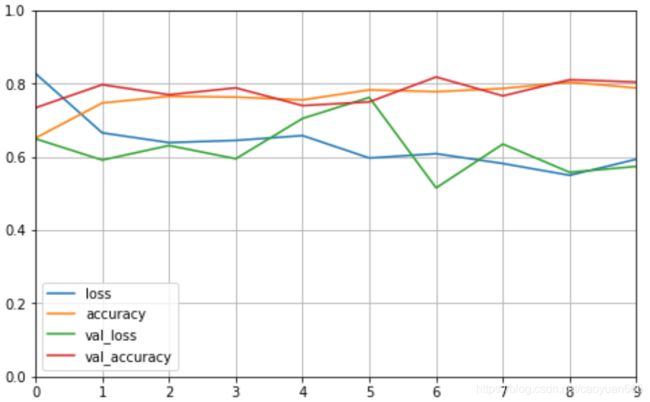TensorFlow2.0入门到进阶2.9 —— 实战深度神经网络
文章目录
- 1、写在前面
- 2、深度神经网络
- 3、举个栗子
1、写在前面
有人会问,2.88在哪呢?其实2.8是一些基础理论知识,这一部分在2.1已经介绍的很详细了,如果不了解看看2.1吧。
这里说个知识点吧:
- dropout
通俗来说,就是将训练好的十分复杂的神经网络,去除一部分连接,如下图所示。那么有人会问,这么费劲训练好的网络,为什么还要去掉一部分连接?这主要是为了提高训练模型的泛化能力。
一般在深度神经网络中应用,由于层数较深,容易出现过拟合,这时候在倒数第一、二层之间通常将如dropout。

详见:https://www.cnblogs.com/fpzs/p/9715044.html
2、深度神经网络
前几节已经讲了神经网络,那何为深度神经网络,通俗来说就是层数很多的神经网络,有什么优点能?如果数据量足够多的话,他所发现的特征会更多,相对来说准确率会更高。下面通过一个20层网络的例子来说明。
3、举个栗子
大体程序和之前那个服装分类的例子一样,如果不了解的小伙伴,看一下:一个服装分类项目轻松入门TensorFlow
import matplotlib as mpl
import matplotlib.pyplot as plt
#为了在jupyter notebook中画图
%matplotlib inline
import numpy as np
import sklearn
import pandas as pd
import os
import sys
import time
import tensorflow as tf
from tensorflow import keras
print(tf.__version__)
print(sys.version_info)
for module in mpl,np,pd,sklearn,tf,keras:
print(module.__name__,module.__version__)
fashion_mnist=keras.datasets.fashion_mnist
(x_train_all,y_train_all),(x_test,y_test)=fashion_mnist.load_data()
x_valid,x_train=x_train_all[:5000],x_train_all[5000:]
y_valid,y_train=y_train_all[:5000],y_train_all[5000:]
print(x_valid.shape,y_valid.shape)
print(x_train.shape,y_train.shape)
print(x_test.shape,y_test.shape)
# x=(x-u)/std 符合正态分布
from sklearn.preprocessing import StandardScaler
#之前x_train为np.int型,所以先转为float32
#fit_transform()为归一化函数,要求输入为一维数组,并将记录均值和方差
#transform()为归一化函数,但不记录均值和方差,使用之前的均值和方差
#reshape(-1,1)表示将原数据转为n行1列的数组,-1根据原数组的数据量决定
scaler = StandardScaler()
x_train_scaled = scaler.fit_transform(
x_train.astype(np.float32).reshape(-1,1)).reshape(-1,28,28)
x_valid_scaled = scaler.transform(
x_valid.astype(np.float32).reshape(-1,1)).reshape(-1,28,28)
x_test_scaled = scaler.transform(
x_test.astype(np.float32).reshape(-1,1)).reshape(-1,28,28)
下面创建网络的方式和之前一样,只不过中间通过一个循环,加入了20层,如果数据足够大的话,可以考虑加入更多层,但是如果数据小,可能出现过拟合。
model=keras.models.Sequential()
#添加输入层,输入的图片展开,Flatten为展平
model.add(keras.layers.Flatten(input_shape=[28,28]))
# 层数达到足够大时构成深度神经网络 DNN
for _i in range(20):
model.add(keras.layers.Dense(100,activation='relu'))
model.add(keras.layers.Dense(10,activation='softmax'))
model.compile(loss='sparse_categorical_crossentropy',
optimizer='adam',
metrics=['accuracy'])
下面具体看一下创建的神经网络:
model.summary()
Model: "sequential_1"
_________________________________________________________________
Layer (type) Output Shape Param #
=================================================================
flatten_1 (Flatten) (None, 784) 0
_________________________________________________________________
dense_21 (Dense) (None, 100) 78500
_________________________________________________________________
dense_22 (Dense) (None, 100) 10100
_________________________________________________________________
dense_23 (Dense) (None, 100) 10100
_________________________________________________________________
dense_24 (Dense) (None, 100) 10100
_________________________________________________________________
dense_25 (Dense) (None, 100) 10100
_________________________________________________________________
dense_26 (Dense) (None, 100) 10100
_________________________________________________________________
dense_27 (Dense) (None, 100) 10100
_________________________________________________________________
dense_28 (Dense) (None, 100) 10100
_________________________________________________________________
dense_29 (Dense) (None, 100) 10100
_________________________________________________________________
dense_30 (Dense) (None, 100) 10100
_________________________________________________________________
dense_31 (Dense) (None, 100) 10100
_________________________________________________________________
dense_32 (Dense) (None, 100) 10100
_________________________________________________________________
dense_33 (Dense) (None, 100) 10100
_________________________________________________________________
dense_34 (Dense) (None, 100) 10100
_________________________________________________________________
dense_35 (Dense) (None, 100) 10100
_________________________________________________________________
dense_36 (Dense) (None, 100) 10100
_________________________________________________________________
dense_37 (Dense) (None, 100) 10100
_________________________________________________________________
dense_38 (Dense) (None, 100) 10100
_________________________________________________________________
dense_39 (Dense) (None, 100) 10100
_________________________________________________________________
dense_40 (Dense) (None, 100) 10100
_________________________________________________________________
dense_41 (Dense) (None, 10) 1010
=================================================================
Total params: 271,410
Trainable params: 271,410
Non-trainable params: 0
观察一下训练结果:
def plot_learning_curves(history):
#设置画布大小为8和5
pd.DataFrame(history.history).plot(figsize=(8,5))
#显示网格
plt.grid(True)
#set_ylim为设置y坐标轴的范围
plt.gca().set_ylim(0,1)
plt.show()
plot_learning_curves(history)
#初期,目标函数基本不变,之后发生变化陡峭原因:
#1、模型较深,参数众多,训练不充分
#2、梯度消失 ->深度神经网络中 链式法则 ->复合函数f(g(x))
